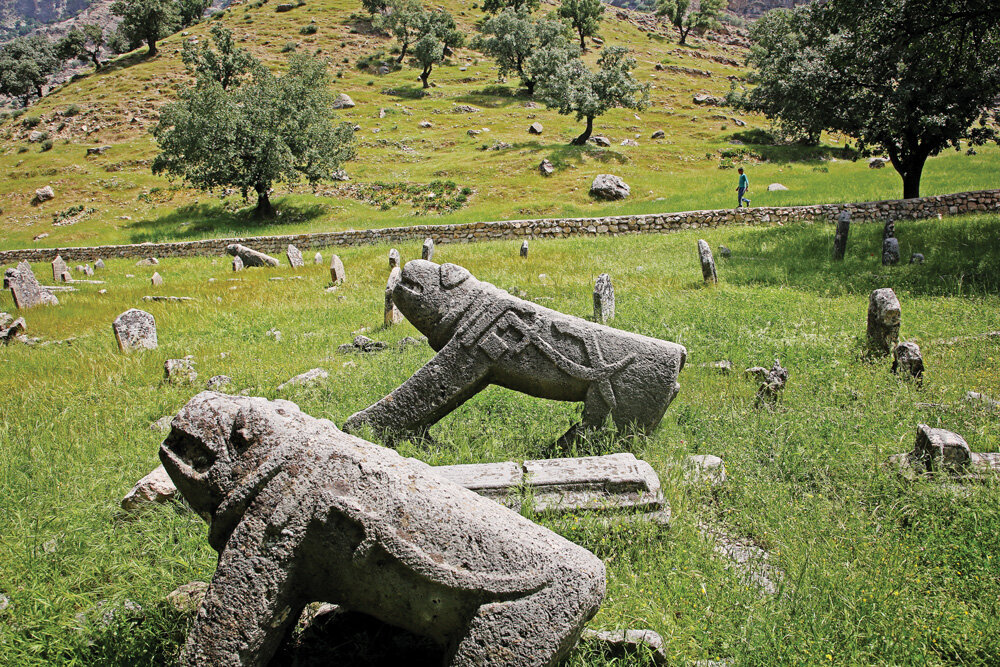Hafshejan projected to be named national city of stone carving

TEHRAN –Hafshejan, a small city in Shahr-e Kord county, southwestern Chaharmahal-Bakhtiari province, is planned to be named as the national city of stone carving, the provincial tourism chief has said.
Stone carvings from Hafeshjan have almost 800 years of history, and the products are not only provincial and nationally famous, but they are also internationally renowned, Alireza Jilan announced on Wednesday.
Currently, 65 artisans are practicing this field in 20 workshops across the city, the official added.
Handmade items in this region are made by extracting stone from the nearby mountains, transporting it to the workshop, cutting it, and then carving the stone by a master craftsman, he explained.
Stone lions, which were placed on top of the tombstones of brave and courageous people of Bakhtiari tribe in the past, are among the most popular stone carving products in the lesser-known province.
Bakhtiari nomads regard such stone statues, locally called ‘Bard Shirs’ as a symbol of bravery, valor, and characteristics like adroitness at hunting and shooting in war as well as horseback riding on top of the gravestone of that group of people.
Scattered across certain graveyards in Chaharmahal-Bakhtiari province, southwest Iran, these statues remind men who enriched the history of their tribes in a mythical form by their names and departed this life.
Chaharmahal-Bakhtiari has various unique traditions and rituals relative to the 'tribal' lifestyles. Special forms of music, dance, and clothing are noteworthy. It has considerable potential to become a vibrant tourist attraction because of its changing natural landscape. The province is also a hub for making wool felt products, majorly of which exported abroad. It is home to some 500 crafters, in over 250 workshops, making handmade felt products.
Currently, about 40 tons of felt are yearly being made in Chaharmahal-Bakhtiari through traditional and modern manners, which could be increased to 50 tons, according to official data. Experts believe that Shahr-e Kord has the potential to be a world city for felt products.
Wide-ranging handicrafts
With 14 entries, Iran ranks first globally for the number of cities and villages registered by the World Crafts Council, as China with seven entries, Chile with four, and India with three ones come next.
In January 2020, the cities of Shiraz, Malayer, and Zanjan and the village of Qassemabad were designated by the WCC- Asia Pacific Region, putting Iran’s number of world crafts cities and villages from ten to 14.
Shiraz was named a “world city of [diverse] handicrafts”. Malayer was made a global hub for woodcarving and carved-wood furniture. Zanjan gained the title of a “world city of filigree”. And Qassemabad village, which is nationally known for its traditional costumes, was also promoted to a world hub of handicrafts. Chador Shab, a kind of homemade outer garment for women, was, however, the main subject for the WCC assessment for the village.
The value of Iran’s handicrafts exports stood at $120 million during the first eleven months of the past Iranian calendar year 1399 (March 20, 2020 – February 18, 2021), Mehr reported. The country’s handicrafts exports slumped during the mentioned months in comparison to the same period last a year earlier due to the damage the coronavirus pandemic has inflicted on global trade.
The Islamic Republic exported $427 million worth of handicrafts during the first eleven months of the calendar year 1398. Of the figure, some $190 million was earned via suitcase trade (allowed for customs-free and tax-free transfer) through 20 provinces, according to data compiled by the Ministry of Cultural Heritage, Tourism and Handicrafts.
Ceramics, pottery vessels, handwoven cloths as well as personal ornamentations with precious and semi-precious gemstones are traditionally exported to Iraq, Afghanistan, Germany, the U.S., the UK, and other countries.
ABU/
Leave a Comment